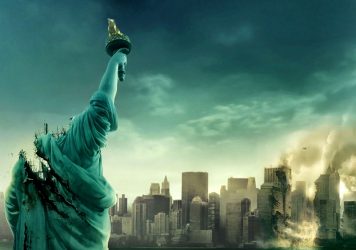
Guillermo del Toro’s Pacific Rim had a difficult time at the box office when it was released back in 2013. Yet despite this, a John Boyega-fronted sequel is one of a number of unexpected monster revivals coming our way this year. Meanwhile, the follow-up to Gareth Edwards’ Godzilla is due to arrive in 2019, before a crossover movie with the eponymous colossus of Kong: Skull Island. Given how risk averse Hollywood studios tend to be, what keeps them coming back to giant, city-destroying creatures?
In 2018 we go to see Hollywood blockbusters for the same reasons we always did, to see something literally larger than life. But in the case of monster movies, there is something more at play. Monsters serve to reflect society’s darkest fears – they transcend culture, eras, even language. Godzilla’s roar needs no translation. At their best, these big screen beasts have the capacity to subtly alter our understanding of the world.
The monster has its roots in the very early days of cinema, when Willis H O’Brien brought dinosaurs to life in 1925’s The Lost World, inspiring future filmmakers like Steven Spielberg and special effects pioneer Ray Harryhausen. It was, however, Willis’ work on 1933’s King Kong that changed cinema forever – on a fundamental level, this great ape represented the fight against vanity and pride within us all.
The vision of this wild, unstoppable animal became an iconic moment in popular culture, and an inspiration for countless films that came after it. The idea that America’s shining metropolis could be terrorised was enthralling to audiences, and there is something inherently enjoyable about watching massive creatures reduce a city to rubble. Indeed, great US landmarks being defiled in some way has been a go-to for a number of genres to this day.
Harryhausen would continue Kong’s legacy with films like The Beast From 20,000 Fathoms and It Came from Beneath the Sea, drawing inspiration from the real life nuclear panic of the 1950s and the echo of World War Two to terrorise audiences.
In this context, it’s no surprise that the monster movie genre resonated most in Japan, which underwent a transformative period more profound than any other world power at the time. Godzilla was perhaps the most iconic of the Japanese monster genre (Kaiju), a consequence of nuclear testing, a nightmare born in the shadows of Nagasaki and Hiroshima. It crystallised a fear in both countries, that humankind’s hubris may be its undoing.
In post-war Japan, the fear of being rapidly thrown into a vast new world, of ever more towering architecture and increasing global trade, could be projected onto the image of a behemoth, presenting something more understandable, and indeed killable than the unknown it represented. This same fear was shared by the US decades later – capitalism was the true monster of the Jurassic Park series, engineering history in order to “slap it on a plastic lunchbox”, as Jeff Goldblum’s Dr Ian Malcolm puts it.

Monster movies allow audiences to experience shared catharsis, relieving the tension and wars between superpowers that haunt so many, with a definable threat and story elements that ring true to the suspicion or angst many may feel.
With the dawn of CGI, suddenly the impossible became possible, and the success of Jurassic Park in 1993 led to a revolution in the monster movie genre. In an ever more frightening world, these films could provide comfortable nostalgia, harking back to the familiarity of Hollywood’s Golden Age and the ’50s B-movie, such as Peter Jackson’s nostalgic King Kong or the knowingly trashy Eight Legged Freaks.
Most recently, the Cloverfield franchise has seen the purpose of these monsters shift, as post 9/11 rhetoric gave rise to the fear of the immigrant and an unsettling concern about US involvement in wars overseas. As the global enemy became less visible and more open to interpretation, these postmodern monsters created a sense of unease and helplessness that we can all identify with.
The follow up films touched on similar paranoias – there’s more than a hint of Doomsday Prepper to John Goodman’s character in 10 Cloverfield Lane, while the mission in The Cloverfield Paradox – to find a sustainable source of energy – evolves the idea of mankind’s folly from nuclear testing to exhausting our natural resources. Whatever the anxieties of the time, Cloverfield’s sparingly exposed monsters could embody it.
While Pacific Rim deals in broader artistic strokes, the series also positions nature the catalyst for chaos. The Kaiju are unstoppable forces of nature that humanity cannot defeat and which must be respected, and this is a message that can’t be displayed quietly. The story also reveals that humanity has created monsters of their own to fight monsters, a poignant image that resonates loudly with the politics of today.
The giant Monster in film serves as monstrous symbol uniquely tailored to a world disconcerted by rapid change and war. King Kong, Godzilla, dinosaurs and Pacific Rim’s Kaiju are not going anywhere because we don’t want them to. We need them. And as long as there are big screens, Hollywood will need giant monsters to fill them.
Published 23 Mar 2018

By Matt Thrift
We take an exhaustive look back at the ups and downs of this iconic movie simian.

Guillermo del Toro choreographs a ballet with giants and offers one of cinema’s most beautiful definitions of love.

By Nadine Smith
Ten years ago, Matt Reeves’ secret monster movie ushered in a new era of fan-driven movie publicity.